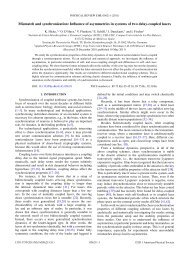DBI Analysis of Open String Bound States on Non-compact D-branes
DBI Analysis of Open String Bound States on Non-compact D-branes
DBI Analysis of Open String Bound States on Non-compact D-branes
You also want an ePaper? Increase the reach of your titles
YUMPU automatically turns print PDFs into web optimized ePapers that Google loves.
CHAPTER 2. BOSONIC STRINGS 32This gives us two equati<strong>on</strong>s relating the mode expansi<strong>on</strong>s <str<strong>on</strong>g>of</str<strong>on</strong>g> X − to those <str<strong>on</strong>g>of</str<strong>on</strong>g> the X i ’s, arelati<strong>on</strong> that can be solved explicity, and for the case <str<strong>on</strong>g>of</str<strong>on</strong>g> the open string the result is(αn − = 1 1l s p + 2D−2∑∞∑i=1 m=−∞: α i n−mα i m : −aδ n,0). (2.119)For the closed string, an analogous relati<strong>on</strong> for ˜α n − exists. Notice the ordering c<strong>on</strong>stanta again. The important point to note, is that now there are no independent oscillatorsleft for X − , so here again, we can no l<strong>on</strong>ger excite our string in the X − directi<strong>on</strong>! Thatis very good news indeed, because looking back at Eq. 2.56, and keeping in mind thatdue to our freshly introduced light-c<strong>on</strong>e coordinates our metric has somehow changed abit, 8 we now see that we are no l<strong>on</strong>ger able to create ghost states, even if we wanted todo so. In other words, the light-c<strong>on</strong>e gauge is manifestly free <str<strong>on</strong>g>of</str<strong>on</strong>g> ghost states.Let us now turn to the mass operator. The generic expressi<strong>on</strong> M 2 = −p µ p µ nowbecomesD−2∑M 2 = −p µ p µ = 2p + p − − p 2 i . (2.120)In order to work this out some more, let us focus <strong>on</strong> the case <str<strong>on</strong>g>of</str<strong>on</strong>g> open (Neumann) strings,and recall that in that caseα µ 0 = l sp µ .Hence, using p − = (l s ) −1 α0 − and Eq. 2.119, we compute that{ [(D−2∑D−2)2p + p − − p 2 i = 2p+ 1 ∑ ∑l s l s p + α−nα i ni + 1 2i=1i=1where we redefinedD−2∑− 1 ls2 i=1[(= 2 D−2 ∑ ∞∑ls2 i=1 n=1(αi0) 2,α i −nα i nn>0)− a],i=1D−2∑+∞∑i=1 n=−∞(αi0) 2]M 2 = 2 ls2 (N − a), (2.121)N =D−2∑i=1 n=1∞∑α−nα i n.iWe see that the mass-shell c<strong>on</strong>diti<strong>on</strong> in light-c<strong>on</strong>e gauge is identical to the <strong>on</strong>e in c<strong>on</strong>formalgauge (Eq. 2.104), except for the fact that we now simply have two directi<strong>on</strong>s lessin which we can excite our string. Hence, our groundstate still has α ′ M 2 |0〉 = −a|0〉.8 More specifically, we get g +− = g −+ = −1, and g ij = δ ij for i, j ∈ {1, . . . , D − 2}. But the tw<strong>on</strong>egatively valued entries corresp<strong>on</strong>d to directi<strong>on</strong>s in which we have no oscillators, and hence we can nol<strong>on</strong>ger create ghosts.− a}
















